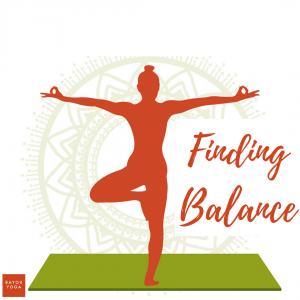How many times have you heard someone say “I’m looking for balance,” “I can’t seem to find balance,” or “It’s all about balance.” It’s what we’re all striving for one way or another. Truth is it’s really about learning to counterbalance. When we’re on the mat, we’re able to experience it. We can feel what it’s like to be balanced, and more importantly we can feel what it’s like to be out of balance. We grow familiar with that feeling and can begin to recognize it in other areas of our lives. It becomes automatic.
The act of balancing on the mat looks like we’re standing in stillness, but it’s actually a series of small and continuous movements back and forth for the body to find that stability. We quickly learn that we need to turn off the noise to allow the mind to turn inwards, pay attention and listen to find what we need. When our body sways to the right, there has to be a counterbalance over to the left to keep us in stability. It’s easy to recognize being out of balance on the mat, but it’s not just the act of being physically balanced. Is the breath syncing with our movements? Is it harder to focus or follow the instructor? Is the music or background noise a distraction today? We can feel it. We just know.
In our day to day lives, we’re always moving, doing or looking for something and that makes imbalance harder to notice. It can show up as rocky relationships, health issues, maybe just feeling depleted. That’s usually indicative of an imbalance in one of the main areas of your life: physical, personal, professional, spiritual, mental or financial.
The three-part definition of a yoga practice encompasses all the tools we need to fix that: tapas (aka “fiery” discipline,) Isvara Pranidhana (surrender) and Svadhyaya (self reflection).
Tapas is about igniting our inner fire and inviting change into the system in order to burn away the habits or habitual thoughts and feelings that tend to keep us stuck. It’s becoming aware of behavioral patterns that don’t serve us. Isvara Pranidhana goes to the opposite end of the spectrum. Instead of trying to change, it’s about being in a state where the only way out is through surrender. Svadhyaya connects the two extremes and helps us find harmony in the system. It’s what’s commonly referred to as self-reflection. Look inwardly, be with yourself long enough to figure out what you want to change and what you need or will surrender to.
The more often you come to your mat, the more these three parts find a way into your yoga practice and the more they show up for you off the mat. Have you had the experience where you find yourself using your pranayama/ breathing to get through a rough patch during your day? That would be yoga sneaking up on you! It has a way of doing that, subtly yet impactfully. That’s how yoga rocks your world. Whether you’re looking for it or not, yoga will pull an “ooops I did it again” and change your life.
Stick with your practice, even when you don’t really want to and allow yourself some space for introspection. Surrender to what is by exercising acceptance and witness the change take place. All you need is a little patience. And you know what helps develop patience? Balance poses 🙂


